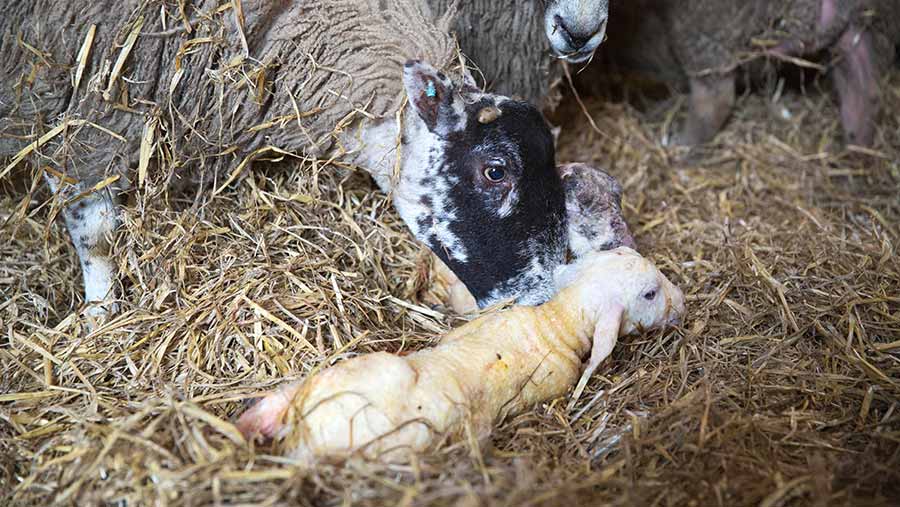16 ways to reduce lamb mortality
 © Tim Scrivener
© Tim Scrivener Adequate, high-quality colostrum for lambs, provided in the first few hours of life, is essential to cutting losses.
Emily Gascoigne, a specialist sheep vet with the Synergy Farm Health practice, explains that minimising mortality relies on a health and feeding programme that begins well before lambing starts.
Advice before lambing
Test forage
Ensuring the ewe is in the right condition ahead of lambing and able to produce high-quality colostrum is vital.
Because a forage-based diet can vary hugely in its protein and energy content, it is important to have silage, hay or haylage tested to adjust rations and improve ewe condition scores.
Carry out a flock health plan
Sit down with your vet prior to the onset of lambing to review protocols, feeding and antibiotic reduction strategies before the rush begins. Prevention is better than cure.
Blood test ewes and analyse your scanning results
High barren rates should be investigated for infectious disease or deficiencies to minimise impact at lambing. This could include trace element analysis of preserved forages to check quality of ration being fed to ewes.
Condition score ewes
To provide good-quality colostrum and feed for lambs, lowland ewes should arrive at lambing time with a condition score of 3-3.5. For upland flocks the appropriate range is 2.5-3.
Where significant numbers are too thin it could be evidence of parasites such as liver fluke, an indicator of high lameness levels or related to feeding.
Addressing issues as soon as possible is important to ensure ewes aren’t too thin heading into the last trimester.
Plan staff
Having enough trained staff to ensure that lambs receive adequate colostrum is vital.
The National Sheep Association and vet schools have lists of more experienced staff and students that can be hired for the crucial busy period.
Provide adequate feed space
Providing adequate feed space for every ewe will allow greater control of condition as lambing approaches.
If concentrate feeding this should be 45cm for a lowland ewe or 30cm for hill ewes.
If ad-lib forage is being fed you should provide 10-12cm per ewe.
It may be worth splitting the flock to provide easier access for younger or thinner animals that may not be able to compete at the trough.
Clean kit
Examine the farm’s lambing kit and clean feeding and tubing equipment with a safe disinfectant like Milton Fluid. If kit is worn or cannot be cleaned don’t leave it – replace it.
Advice immediately after lambing
Supply colostrum quickly
Lambs need to be fed colostrum equivalent to about 10% of their birthweight in the first six hours and 20% in the first day. A good method of weighing lambs is to use an Ikea bag and a suitcase weigh scale.
- 3kg lamb: provide 600ml (1 pint approx.)
- 4kg lamb: provide 800ml (1.4 pints approx.)
- 5kg lamb: provide 1,000ml (1.75 pints approx.)
Check colostrum quality
Assessing the colostrum quality using a Brix reflectometer will identify which lambs may need to receive supplemental colostrum.
The Brix score should be above 22% (protein level).
Only remove and freeze the best-quality colostrum from ewes. Take care at defrosting – colostrum should not be microwaved or heated in boiling water as this damages the vital proteins in colostrum.
Individual penning
Ewes and their newborn lambs should be moved to be cleaned and disinfected, and put into individual pens to help them bond, make observation easier and aid provision of colostrum.
Check the ewe
The ewe’s udder should be checked to ensure there is no late mastitis and that both teats are supplying colostrum.
Ensure the ewe is well-bonded with her lambs. For difficult lambings, consult your flock plan with regards to appropriate pain relief management in these animals.
Check the lambs
Dip lamb navels with iodine as soon as possible to prevent joint ill and then check their eyes. A condition called entropion, or in-turned eyelids, can prevent lambs from feeding.
Some lambs may need teat training, especially if they are dopey or the ewe’s udder is low. Any doubts on whether the lamb has had sufficient colostrum – use a stomach tube.
Identify weaker lambs
Any lambs that may be at high risk of missing out on early colostrum should be identified – such as triplets or animals that have endured a difficult lambing. These should be stomach-tubed rather than waiting for them to suck.
Supplement colostrum
If lambs have not received enough colostrum for any reason it should be supplemented with good-quality, Brix-tested ewe’s colostrum before six hours old (when brown fat that is keeping the lamb warm runs out).
If this is not available, artificial colostrum replacers or bovine colostrum can be used. For the bovine substitute, the donator cow should be BVD- and Johnes-free and not from a unit under TB restrictions.
First few days post-lambing
Monitor mortality
Flock keepers should be aware of target mortality and record rates as lambing time progresses.
From scanning to sale, mortality should not exceed 14%. Losses are most common in the period between birth and the first 48 hours of life. Beyond this time-period, mortality rates should be less than 2%. Any losses above this should be investigated for causal agents like clostridia.
Turn-out precautions
A well-bonded lamb with a full belly of milk can withstand a lot.
But, where it is possible, provide shelter from wind chill which can hit growth rates.
For the ewe, pre- turn-out offers a chance to tackle footrot. This is a contagious disease and will be passed to lambs on heavily stocked pasture. Ewes with active lesions should be treated with systemic antibiotics and isolated indoors in accordance with your flock health plan.
